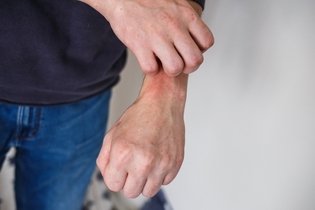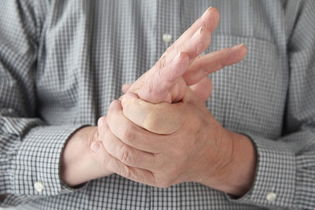Folliculitis is the inflammation of a hair follicle. Affected regions will present with itchy, red bumps. It can be treated at home by cleansing the area with antibacterial soap, but the use of specific creams and ointments may be necessary, as indicated by your doctor dermatologist.
Folliculitis is usually caused by ingrown hairs, but it can also be the result of a bacterial or fungal skin infection. It can cause symptoms like redness, burning, itching and the emergence of small, acne-like, pus-filled blisters.
Folliculitis is most common in the buttocks, legs, groin, legs, arms, and beard. It especially occurs in people who wear tight clothing, shave their hair or wear makeup.

Common symptoms
The main symptoms of folliculitis are:
- Red blisters, which look like acne;
- Small blisters with pus at the root of the hair;
- Itching in the area;
- Pain and sensitivity in the skin;
- Redness and swelling in the area.
The small red bumps usually appear in clusters and can any area containing hair, such as the face, arms, armpits, legs, buttocks or groin. Learn more about what causes bumps on the skin and what to do.
Usually, folliculitis symptoms improve within a few days without any specific treatment. However, in some cases, this condition can worsen, causing a boil. A boil is characterized by an infection that causes the formation of a lump with pus, redness, heat in the area or pain.
Confirming a diagnosis
Folliculitis can be diagnosed through assessment of the skin. It is important for the diagnosis to be confirmed by a dermatologist through a physical examination, in order to confirm the diagnosis and start the most appropriate treatment.
Types of folliculitis
Folliculitis can be classified into different types depending on where it is located:
- Folliculitis in the groin: shaving with razors or waxes can ingrown hairs, favoring the appearance of this type of folliculitis. In addition, wearing tight clothing can increase friction, heat and humidity in the area, leading to a bacterial infection and folliculitis.
- Folliculitis of the scalp: this can be caused by fungi or bacteria and can appear in people who wear wigs, caps, hats or helmets frequently. This type of folliculitis is characterized by small pus-filled balls that itch and hurt.
- Folliculitis on the buttocks: this is quite common in both men and women and is caused by bacteria, leading to the appearance of small red, pus-filled and painful balls.
- Genital folliculitis: can be caused by shaving in this area, because in some cases the hair becomes blocked and grows under the skin, causing inflammation.
- Folliculitis on the legs: this can arise from shaving with razors or wax, or from infections caused by bacteria, fungi or viruses.
- Folliculitis in the armpits: can appear in both men and women, and is usually caused by waxing or shaving, causing itchy, sore red bumps with pus.
- Folliculitis on the face: this type of folliculitis can be caused by the use of razors or waxes, affecting the entire face and the beard area.
Folliculitis can also appear on areas such as the back, shoulders, arms and neck, and can be caused by fungi or sun exposure.
Possible causes
Folliculitis is usually caused by the growth of fungi, viruses, mites or bacteria on the skin, around the scalp or anywhere with body hair, causing inflammation.
Some factors that can also lead to the appearance of folliculitis are:
- Frequent shaving or waxing
- Wearing tight clothes
- Frequent use of helmets, hats, wigs or long boots
- Having dermatitis or acne
- Poor skin or hair hygiene
- Frequently using bandages or adhesive strips on hair
- Using baths or saunas that are not properly sanitized
- Using medication such as antibiotics, lithium or cyclosporine for prolonged periods
In addition, people with diseases such as diabetes, obesity or HIV are also at greater risk of developing folliculitis.
Treatment options
Treatment for folliculitis should be recommended by a dermatologist and varies depending on the cause of the condition and the area affected. It can include proper hygiene, ointments, medicines, soaps or surgery.
1. Proper hygiene
In mild cases of folliculitis, proper hygiene of the skin and scalp, using soap, shampoos and warm water can resolve the condition within 7 to 10 days.
2. Ointments
Ointments such as mupirocin and clindamycin can be used to fight bacteria and relieve the symptoms of folliculitis, such as itching and pain.
For the treatment of folliculitis caused by fungi, the doctor may prescribe the use of ointments such as itraconazole and fluconazole.
3. Oral antibiotics
When ointments are inefficient in treating folliculitis, antibiotics such as cephalexin, ampicillin, or ciprofloxacin may be prescribed by the doctor to help fight the bacteria.
4. Shampoos
Frequent washing of the hair with anti-dandruff shampoos containing ketoconazole or ciclopirox olamine, for example, may be indicated mainly for the treatment of folliculitis on the scalp.
5. Soaps
Local hygiene with antiseptic soaps and warm water can be indicated for the treatment of folliculitis on the face, beard, legs, genitals and groin, for example.
6. Surgeries
In cases of deeper folliculitis or boils, the doctor may perform a small surgery to remove excess pus, thus relieving symptoms and helping with healing.
Other care to treat folliculitis
Some precautions that also help in the treatment and prevention of folliculitis include:
- Place a warm compress on the affected area to reduce itching
- Take a shower with neutral soap immediately after using the pool, bathtub or sauna
- Do not scratch or pick at the bumps
- Perform laser or pulsed-light hair removal
- Avoid using creams, perfumes or other irritating products on the lesions
- Use an electric shaver instead of razors.
- Avoid frequently wearing hats, helmets, wigs or caps
- Wear looser clothing
If folliculitis symptoms do not improve after 2 weeks, you are advised follow-up with your dermatologist again for reassessment and treatment alternatives.








